
Filipendula ulmaria, commonly known as meadowsweet or mead wort, is a perennial herbaceous plant in the family Rosaceae that grows in damp meadows. It is native throughout most of Europe and Western Asia. It has been introduced and naturalised in North America.

Powdery mildew is a fungal disease that affects a wide range of plants. Powdery mildew diseases are caused by many different species of ascomycete fungi in the order Erysiphales. Powdery mildew is one of the easier plant diseases to identify, as its symptoms are quite distinctive. Infected plants display white powdery spots on the leaves and stems. The lower leaves are the most affected, but the mildew can appear on any above-ground part of the plant. As the disease progresses, the spots get larger and denser as large numbers of asexual spores are formed, and the mildew may spread up and down the length of the plant.

Erysiphales are an order of ascomycete fungi. The order contains one family, Erysiphaceae. Many of them cause plant diseases called powdery mildew.
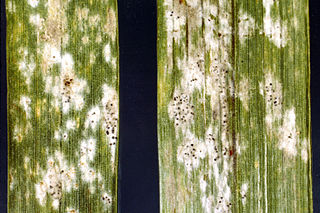
Blumeria graminis is a fungus that causes powdery mildew on grasses, including cereals. It is the only species in the genus Blumeria. It has also been called Erysiphe graminis and Oidium monilioides or Oidium tritici.
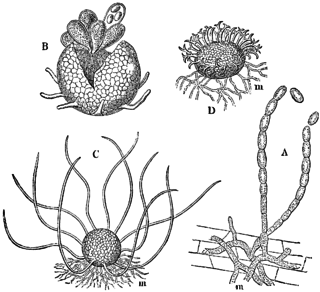
Erysiphe cruciferarum is a plant pathogen of the family Erysiphaceae, which causes the main powdery mildew of crucifers, including on Brassica crops, such as cauliflower, cabbage, broccoli, and Brussels sprouts. E. cruciferarum is distributed worldwide, and is of particular concentration in continental Europe and the Indian subcontinent. E. cruciferarum is an ascomycete fungus that has both sexual and asexual stages. It is also an obligate parasite that appears to have host specificity; for example, isolates from turnip will not infect Brussels sprout, and vice versa. While being a part of the family Erysiphaceae, it belongs to those members in which the conidia are formed singly and whose haustoria are multilobed.

Podosphaera leucotricha is a plant pathogen that can cause powdery mildew of apples and pears.
Brasiliomyces malachrae is a species of fungus in the family Erysiphaceae. It is a plant pathogen that grows on Gossypium, Lavatera assurgentiflora, Malachra capitata, Malvastrum coromandelianum, and species of Malvaceae. It is found in South America.

Podosphaera macularis is a plant pathogen infecting several hosts including chamomile, caneberrie, strawberries, hop, hemp and Cineraria. It causes powdery mildew of hops.

Podosphaera pannosa is a plant pathogen. It produces a powdery mildew on members of the rose family.

Oidium mangiferae is a plant pathogen that infects mango trees causing powdery mildew. Powdery mildew of mango is an Ascomycete pathogen of the Erysiphales family that was initially described by Berthet in 1914, using samples collected from Brazil. O. mangiferae is found in all areas where mangoes have been raised long term, but is particularly widespread in India where both the host and the pathogen are native. Currently no teleomorph stage has been identified, but due to certain morphological characteristics it has been suggested that O. mangiferae belongs in the Erysiphe polygony group. Mango is the only known host for this pathogen, though O. mangiferae appears to be identical to fungi responsible for powdery mildew diseases on various other plant species, particularly oak, though some differences may be observed. In particular, the number of cells in conidiophores varies from 2 on mango to 3-5 on oak. O. mangiferae has been known to infect oak leaves in the laboratory, however due to the lack of a known teleomorph stage O. mangiferae is still considered to only be a pathogen of mango. Recent analysis of its ribosomal DNA suggests it is conspecific with Erysiphe alphitoides, the causative agent of powdery mildew in European oaks.
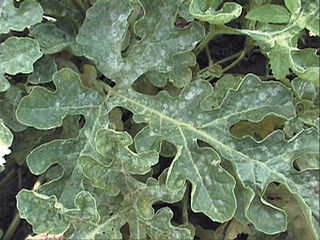
Podosphaera fuliginea is a plant pathogen that causes powdery mildew on cucurbits. Podosphaera fuliginea and Erysiphe cichoracearum are the two most commonly recorded fungi causing cucurbit powdery mildew. In the past, Erysiphe cichoracearum was considered to be the primary causal organism throughout most of the world. Today, Podosphaera fuliginea is more commonly reported.

Podosphaera fusca is a fungus that parasitically infects plants. It is one cause of powdery mildew in melons and gourds.

Uncinula is a genus of fungi. Its species are plant pathogens that cause powdery mildew diseases on various plant hosts. The genus is characterized by its dark chasmothecia which bear filamentous, hyaline appendages with hooked tips. Over one hundred species have been described from mostly dicotyledenous hosts. Braun and Takamatsu (2000) suggested that Uncinula should be considered a later synonym of Erysiphe; not all subsequent researchers have accepted their conclusions.

Podosphaera is a genus of fungi in the family Erysiphaceae. Species in this genus are plant pathogens, causing powdery mildew.

Phyllactinia is a genus of fungi in the family Erysiphaceae. The type species was Phyllactinia suffulta, which is now the synonym for Phyllactinia guttata.

Microsphaera is a genus of powdery mildew in the family Erysiphaceae.

Ampelomyces quisqualis is an anamorphic fungus that is a hyperparasite of powdery mildews. This parasitism reduces growth and may eventually kill the mildew. These mycoparasites can live up to 21 days on mildew-free host plant surfaces, attacking powdery mildew structures as soon as they appear. A. quisqualis is used as the active ingredient in a commercial fungicide.
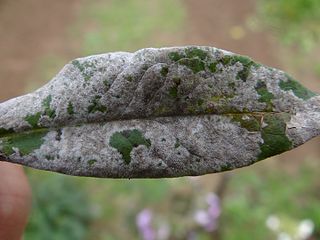
Golovinomyces is a genus of fungi in the family Erysiphaceae. It has 66 species. Many of the species cause powdery mildew. Golovinomyces was originally circumscribed in 1978 by Uwe Braun as a section of genus Erysiphe. It was promoted to distinct genus status in 1988.
Erysiphe azerbaijanica is a species of powdery mildew in the family Erysiphaceae. It is found in Azerbaijan, where it grows on the leaves of sweet chestnut trees.
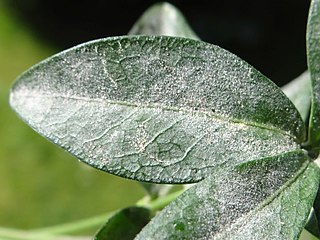
Golovinomyces orontii is a species of fungus that causes powdery mildew disease and it is in the family Erysiphaceae. It is an obligate biotroph that infects plants in several families including Acanthaceae, Asteraceae, Brassicaceae, Cucurbitaceae, and Lamiaceae.

















